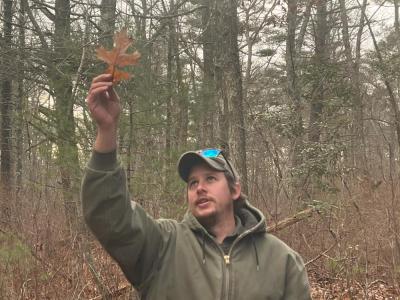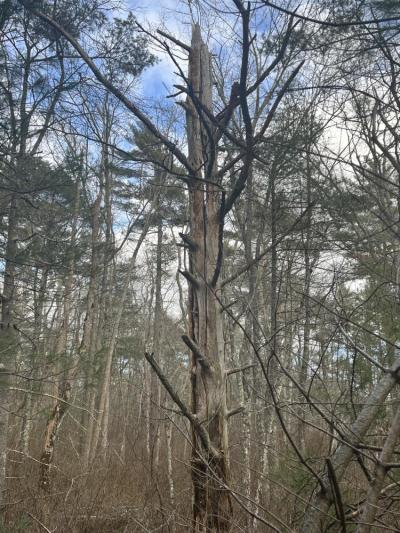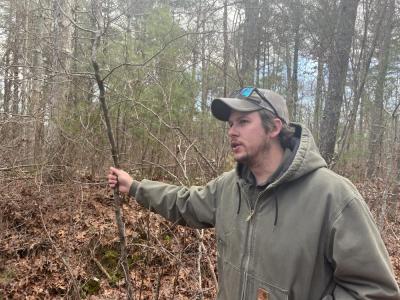Leaf it all to Chance: Arborist leads tour of local forest
If a tree falls in the forest, and no one is around to hear it, does it make a sound?
Ask New Bedford conservation agent Chance Perks, and he’ll answer with a terse, immediate “yes.”
“In fact,” he said, “it makes more of a sound when no one’s around.”
Perks is less interested in the sounds that fallen trees make and more interested in the immeasurable impact they make on local ecosystems.
Even old dead trees, which arborists like Perks call “snags,” provide a habitat for various plant and animal species, as well as a jumping-off point for tree reproduction.
“The tree that just died is now offering itself for its babies to live on it,” he said.
Perks, 34, has spent his life studying the forests of southeastern Massachusetts and humanity’s impact on them. On Wednesday, Jan. 11, Perks led a group of hikers through the Tweedy and Barnes Preserve on Blackamore Pond Road for a Winter Tree ID.
“It’s humbling in terms of how old [trees] get, and their complexities,” he said. “It almost makes me feel small, and I kind of like that. It makes me know everything is going to be okay. Have you ever not been around trees? You get a weird feeling.”
The event was part of the Wareham Land Trust’s Winter Wonder series of cold-weather nature programming.
“The diversity in insects, the diversity in birds, the diversity in trees, just within this 100 feet, is pretty significant in southeastern Massachusetts,” Perks told the hikers as they trekked through the preserve.
For years, the Tweedy and Barnes Preserve has been one of Perks’s favorite places. One of the first photos ever taken of him shows him at two weeks old, “stark naked” at the Preserve with his father.
“I think it’s genetic,” Perks said of his love of trees. “My father was an avid outdoorsman. I come from a tradition of stewardship. We have to take care of this stuff.”
The trail that Perks and the hikers walked once belonged to railroad tracks. The arrival of Europeans, and the beginning of the industrial age, drastically altered the composition and biodiversity of the forest.
Perks can learn the history of the forest, and how much the landscape has changed, simply by looking at the trees.
“We don’t know what we’re truly disturbing,” he said. “It’s my opinion, and the opinion of others, that we wiped out things that we never knew existed.”
Perks speaks of trees in rapturous, often anthropomorphic terms. As he spoke, he was bouncy with excitement. His hands were restless.
He said white oaks were “chilling” in the wooded Preserve.
Sassafras trees are “really cool,” he said, with “a kind of interesting bark.”
Pitch pines are some of his favorites, “though they’re kind of scraggly.”
Greenbrier is “beloved” but also “a pain in the butt.”
He said that cattail roots are “one of the best food sources around” if you’re stranded in the wilderness.
“They’re like potatoes,” he said. “They’re really nutritious and wonderful.”
To him, a gnarly pine tree “has character to it.”
Even weevils are “cute as hell” in his eyes.
He admired a plethora of clethra and praised the “really awesome” blueberries that grow in the Preserve during the warmer months. He appreciated the “architecture” of the blueberry plant, how angular the branches were as they stretched out over his head. He found beauty in the reddish color of the wood and the green lichens growing on it.
“The smaller stuff is actually more important,” he said. “We can talk about trees, but when we’re talking about the health of our environment, the things we need to watch out for, lichens are a beautiful thing.”
He closely studied “cute little bundles” of pine needles and luxuriated in their softness.
He studied the galls left behind by the trees, which he said are “as varied as the clouds.”
Galls are created when insects lay their eggs in the trees. When the galls fall to the forest floor, they become the home of other insects. There is a species of ant, Perks said, that only lays its eggs inside galls.
“We don’t even know how complex this is,” he said. “We’re still studying it. We’re still realizing that this little deformation has a huge host of relations that we’re still trying to figure out.”
He happily touched fungi and tasted a winter green leaf, savoring its minty flavor. He invited the hikers to do the same, but warned that the plant is a powerful laxative.
As he walked further and further down the trail, he noticed the structure and age of the forest changing. The trees were getting younger.
“It’s really nice to see regeneration,” he said. “A good community is composed of everyone. Same thing for a forest.”
After the hike, local residents told Perks about their fight against the deforestation that would be caused by proposed solar farms.
“We all like our energy,” he said. “We all need energy, so what’s the alternative? You can get involved without having to come here and get in the woods. You can be a speaker for the trees in many ways. I don’t care if you’re an engineer, a fashion designer or a computer analyst, we’re all involved in our natural base.
Perks proudly calls himself a tree hugger, but said that people don’t have to be in order to promote environmental health.
He encouraged everyone to support their local Land Trust through volunteering and word of mouth, and to pay attention to what their local Conservation Commission is doing.
“We’re creatures of the trees,” he said. “We need them for our psyche… We all have our quirks and trees happen to be one of mine.”
















